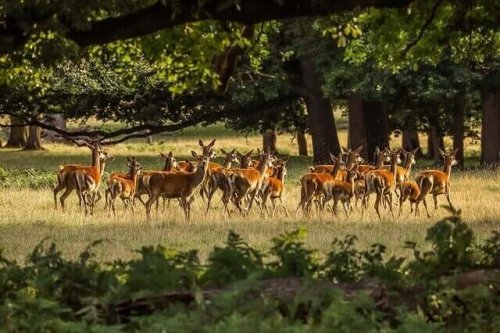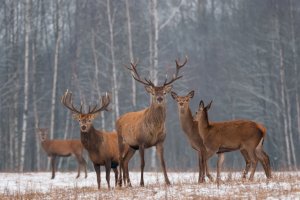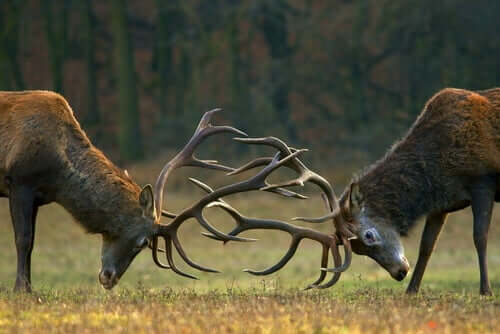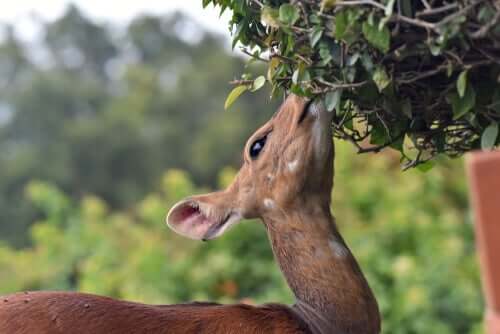Deer Herds: Feeding Habits and Habitats

There are some animals that live solitary lives and only come together with another member of their species for courting and mating. There are others who pair with others for life, and there are some who live in large groups and migrate from place to place. Deer herds fall under this last group.
Stags and does belong to the Cervidae family. There are several different species that also belong to this group. The biggest member is the elk, at 992 lbs, and the smallest is the Pudu, at just 22 lbs.

Deer are large ruminant mammals with bodies similar to those of horses, but they are slightly shorter and stockier. They have slender feet, cloven hooves, long necks, and antlers. However, these characteristics can vary depending on the deer species and the habitat in which they live.
Where do large deer herds live?
Deer live in several regions around the world, including Europe, Asia, America, North Africa and several areas of the Arctic. Humans have also introduced deer to New Zealand and Australia.
As deer species live across such a wide region, their habitats are found in very diverse ecosystems. These can range from vast plains, prairies, forests and tundra, to tropical rain forests and mountain forests.
Individuals of a deer species can live in quite a large area, either in large groups, smaller herds or alone. In fact, this area can extend up to 25 miles. Deer such as caribou migrate over large distances in search of food throughout the year, traveling hundreds of miles from tundra to warmer areas.
How do large deer herds live?
It’s very common for male deer to live solitary and isolated lives. They are territorial and every deer will have his own “turf”. Female deer live in large groups or with their young.
Male deer mark out their territory using pheromones, either by leaving deep footprints or by rubbing their heads against trees to cover them in their smell. The deer’s feet and heads contain the glands that release pheromones.
During the breeding or rutting season, the stags fight between themselves for the right to mate with a harem of females. However, this behavior can change depending on the deer species.

This ritual fighting means that the stags don’t need to be truly aggressive towards one another with their antlers. Their behavior, which always follows a distinct pattern, helps the stags to distinguish themselves from one another. Their aim is to show off their individual attributes to intimidate their opponent. This is known as agonistic behavior.
What do deer feed on?
Deer are herbivores, which means that their diet consists mainly of woody and herbaceous plants. The latter are usually more abundant in the spring, whereas woody plants become more vital to a deer’s diet during the autumn and winter periods.
Deer in Europe feed mostly on pines and, generally, on all conifers. They also frequently feed on leafy shrubs and grasses.
The amount of woody and herbaceous plants in a deer’s diet can vary, depending on whether they live in a cold or a mild climate. Deer also eat lichen, leaves and flower stems. In addition, they use their feet to dig out roots and tubers from the ground.

Depending on the season, deer also feed on wild fruits, acorns and mushrooms. They sometimes also invade local farms, which on one hand can be a problem to local farmers. On the other hand, it’s also true that the farms have, in fact, invaded the deer’s natural habitat.
As mentioned, deer are ruminant animals. This means that they regurgitate the food they have eaten and then digest it again. By “chewing the cud”, they can further digest their food to absorb extra nutrients that, otherwise, they wouldn’t be able to obtain.
Like other ruminant animals, a deer’s digestive system has four parts, namely the rumen, the reticulum, the omasum and abomasum. The rumen contains the microorganisms that can digest plant cellulose and create products that the deer can use as an energy source.
All cited sources were thoroughly reviewed by our team to ensure their quality, reliability, currency, and validity. The bibliography of this article was considered reliable and of academic or scientific accuracy.
- Venadopedia
- I. Garin, A. Aldezabal, R. García–González & J. R. Aihartza. Composición y calidad de la dieta
del ciervo (Cervus elaphus L.) en el norte de la península ibérica. Animal Biodiversity and Conservation 24.1 (2001).